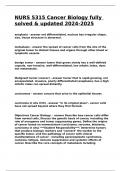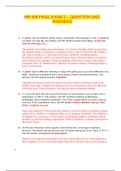NURS 5315 Cancer Biology fully
solved & updated 2024-2025
anaplasia - answer not differentiated, nucleus has irregular shape,
size, tissue structure is abnormal.
metastasis - answer the spread of cancer cells from the site of the
original tumor to distant tissues and organs through other blood or
lymphatic vessels.
benign tumor - answer tumor that grows slowly has a well-defined
capsule, non-invasive, well-differentiated, low mitotic index, does
not metastasize.
Malignant tumor (cancer) - answer tumor that is rapid-growing, not
encapsulated, invasive, poorly differentiated (anaplasia), has a high
mitotic index can spread distantly.
carcinomas - answer cancers that arise in the epithelial tissues
carcinoma in situ (CIS) - answer "in its original place", cancer cells
have not spread beyond where they first formed.
Objectives Cancer Biology: - answer Describe how cancer cells differ
from normal cells, Discuss the genetic basis of cancer, including the
role of oncogenes and tumor suppressing genes, Define the origins
of cancer based on nomenclature (carcinoma, sarcoma, blastoma,
carcinoma in situ) ***Student Responsibility***: Determine tumors
that produce biologic markers and "connect" the marker to the
specific tumor. Link the pathology of cancer with clinical
manifestations of cancer - including paraneoplastic syndromes,
cachexia, fatigue, immune suppression and systemic effects of
cancer. Describe the core concepts of metastasis including
,mechanisms and patterns of metastasis. Identify the TNM staging
for cancer.
Benign Tumor: - answer Slow growth, well-define capsule, a
noninvasive, well differentiated, low mitotic index, does not
metastasize
malignant tumor (cancer): - answer rapid growth, not encapsulated,
invasive, poorly differentiated: anaplasia, high mitotic index, can
spread distantly (metastasis)
anaplasia: - answer not differentiated, nucleus has a regular shape,
size, tissues structure is abnormal
metastasis: - answer the spread of cancer cells from the site of the
original tumor to distant tissues and organs through either blood or
lymphatic vessels
carcinomas: - answer cancers arising in epithelial tissue
carcinoma in situ: - answer "in its original place", cancer cells not
spread beyond where they first formed
adenocarcinoma: - answer cancer arising from ductal or glandular
structures
sarcoma: - answer cancer arising from mesenchymal tissue
lymphoma: - answer cancer of lymphatic tissue
blastoma: - answer malignancy in precursor cells "blasts"
, leukemia: - answer cancers of blood-forming cells
blastoma: - answer cancer, more common in children, that is caused
by malignancies in precursor cells, often called blasts. Examples are
nephroblastoma, medulloblastoma, and retinoblastoma.
-oma: - answer Suffix from Greek, "morbid growth, tumor"
3 characteristics/hallmarks of cancer: - answer abnormal,
uncontrolled, spread
Cancer definition: - answer any type of malignant growth or tumour,
caused by abnormal and uncontrolled cell division: it may spread
through the lymphatic system or blood stream to other parts of the
body.
Cancer Word Origin: - answer C14: from Latin: crab, a creeping
tumour; related to Greek karkinos crab, Sanskrit karkata
Lung cancer incidence: - answer men is 15% incident and for
females are 14%
Lung cancer death rate: - answer men is 31% for women is 26%
Highest cancer death rate for men: - answer prostate cancer it has
10% death rate
Highest cancer death rate for women: - answer Lung cancer 26%
death rate






